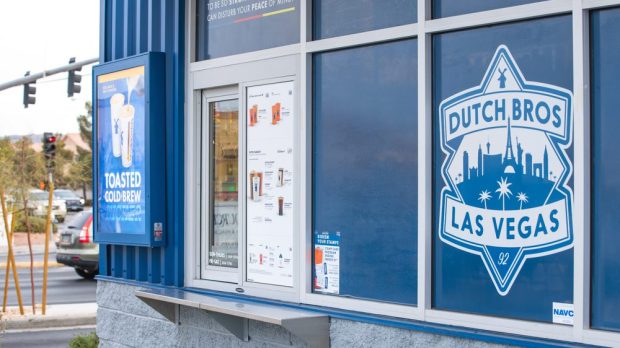Dutch Bros. Doubles Down on Face-to-Face Servers, Won’t Remove People From Process

As restaurant brands turn to digital order-taking and service technologies to minimize labor in today’s challenging staffing market, Dutch Bros. is choosing to keep human servers central to the ordering experience. On a call with analysts on Wednesday (Nov. 10) discussing its first quarterly earnings release since going public, the Grants Pass, Oregon-based drive-thru coffee chain highlighted this face-to-face interaction as a key differentiator for the brand.
“Unlike most drive-thru experiences that begin with maybe a muffled speaker at a faceless menu board, every Dutch Bros. experience starts with an in-person human connection,” said the chain’s President and CEO Joth Ricci. “We place a premium on quality, speed and service without bypassing the personality of our brand, the Broista.”
Meanwhile, other major restaurant chains have been looking for ways to remove the human server from the experience. Most recently, in late October, McDonald’s announced that it is partnering with IBM to assist in developing and implementing automated order-taking (AOT) capabilities in a bid to seize on the popularity of the drive-thru channel while circumventing the labor costs.
Read more: McDonald’s Teams With IBM to Super-Size Drive-Thru Lane Tech
Similarly, while other restaurant brands are encouraging consumers to adopt the mobile order-ahead channel, effectively outsourcing the order-taking labor to the customer, Dutch Bros. has been resistant to push technologies that minimize contact with human servers.
“There’s opportunity operationally to improve order-ahead, walk-up windows, [but] in a Dutch Bros. way, because we will always maintain the service aspect of what we do, and we think that is an important element to who we are — we don’t ever want to remove that,” said Ricci.
He added that improvements would focus on educating the barista with more information about each customer, using digital tools to improve the human service rather than eliminating it. Given these concerns, as it stands, the app does not offer mobile order-ahead, though Ricci noted that the feature is “certainly on our radar,” indicating that the company would have news on that front in the next three to six months.
Mobile order-ahead capabilities can go a long way toward driving sales for major restaurant brands. Research from PYMNTS’ Restaurant Readiness Index, created in collaboration with Paytronix, finds that 20% of chain quick-service restaurants’ (QSRs’) sales come through mobile order-ahead, which is significantly more than the share coming through online delivery channels and twice as many as inside-the-restaurant orders.
Read more: QSRs’ Lagging Loyalty-Reward Investment Hurts Innovation and Sales
Still, even with this focus on face-to-face service, the company’s digital channels are doing some heavy lifting. Charley Jemley, the company’s CFO, shared that around 60% of tender comes through rewards members. Research from the Index finds that consumers rank the availability of a loyalty rewards program as the top way to encourage them to spend more on their food orders, above even the ability to order and pay online.
“We get a higher average check from loyal customers, but you would expect that because they are loyal customers, so a lot of what we’re seeing is just good solid traffic growth,” said Jemley. Ricci added that building out this program and the mobile app is in the “top one, two, three in priorities related to the development of this business.”
